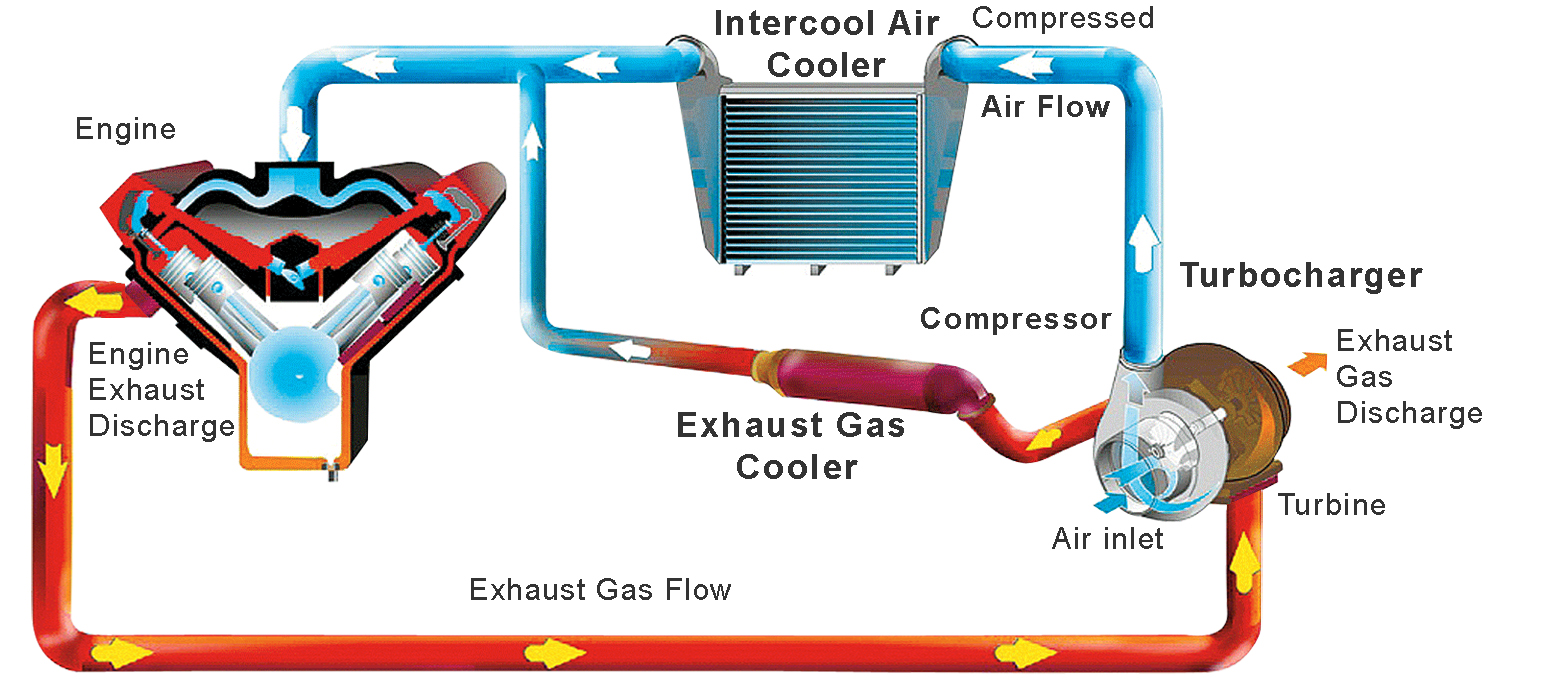Turbocharger
The history of the turbocharger dates almost as back as the internal combustion engines. In 1885 and 1896, Gottlieb Daimler and Rudolf Diesel examined the compression of the intake air in order to increase the engine power and reduce the fuel consumption. In 1925, Swiss engineer Alfred Büchi became the first person to produce a turbo unit which uses the exhaust gas, thus achieving a 40% increase in power. This has led the turbocharger to officially become a part of the automotive industry. Turbocharger is a type of pump which allows increasing the power output of the engine with a smaller volume, by forced filling air above the atmospheric pressure to the engine, and which is powered by the pressure of the exhaust gas. It has two propellers called the turbine and the compressor. The turbine is located on the exhaust side, and the compressor is on the intake side. Rotating with the exhaust pressure of the exhaust gas, the turbine rotates the compressor through a connecting shaft in-between. Thus, a significantly increased air intake is provided to the engine cylinder.
Turbocharger Working Principle

The burnt air-fuel mixture in the combustion chamber transforms into the exhaust gas and it is pushed through the exhaust valves towards the exhaust manifold. At this stage, the pressure of the gas moving to the exhaust rotates the propeller of the turbo on its path. Thanks to this propeller which has multi directional blades, a significant portion of the gas enters the turbine. Once the turbine is filled with pressurized gas, the compressor on the opposite direction starts to rotate as well. This rotating propeller creates a reverse pressure in the air intake part of the compressor housing and generates a suction. As a result of that, the compressed air filled into the housing is pushed from the exhaust part of the housing towards the intake manifold. This allows the compressed air entering the combustion chamber to cause a much more violent explosion when it is ignited together with the fuel.
Causes Of Failure
Insufficient Lubrication:
You should pay attention that the oil level isn’t low in vehicles with turbochargers. Depending on the severity of the lack of lubrication, shafts and bearings may wear by rubbing against each other, generate noise and cause gaps in-between.
Usage of Low Quality Oil:
The oil with the specifications that is recommended by the manufacturer should be used. For turbocharged engines, it is important to use a synthetic oil. Oils with poor quality loses their lubrication properties at high temperatures, their viscosity becomes incompatible with the turbocharger and they can’t lubricate the turbo bearings sufficiently, thus the turbo fails.
Not Replacing the Oil on Time:
You have to pay attention to the periodic maintenance periods. When the engine oil level is low or when the oil is replaced too late, it may cause a turbocharger failure since the oil loses its properties in time.
Occurrence of Clearances in Turbocharger Shaft, Bearings and Bushings:
Sometimes, even if it is not caused by a malfunction, shaft-bearings-bushings structure may wear out over time due to the usage of turbocharger, and this may cause gaps. In such a case, turbocharger makes a whistling sound. You can fix this by performing a turbocharger overhaul.
Ingress of Solid Particles into the Turbo Air Intake:
The ingress of unwanted solid particles (metal particles) into the air inlet of the turbocharger causes the blades to bend or break. Impact of these particles on the turbine blades on the exhaust side causes damage to the blades likewise.
Exhaust Gas at Extreme High Temperatures:
Extremely hot exhaust gas, increased pressure in the engine and insufficient cooling of the turbocharger may damage the bearings of the turbo shaft, causing the housing to bend and rub against the blades.
Points to be Considered while Using a Turbocharged Vehicle
The turbocharger is lubricated with engine oil, the engine oil is pumped by the oil pump into the engine oil ducts and into the oil inlet of the turbocharger. Starting the engine and stopping immediately after a few seconds damages the turbo since the turbo has started to rotate rapidly and the engine oil has not yet lubricated the turbo sufficiently. Moreover, the lubricating property of the oil is decreased in a cold engine.
After a journey of using the vehicle at medium and high speeds, let the engine idle for about a couple of minutes so that the turbo slows down while it’s lubricated. The turbo shaft continues to rotate rapidly and it takes some time to stop after turning the engine off. If you stop the vehicle and turn off the engine immediately, you would cut off the lubrication of the turbocharger while it’s still rotating rapidly. In this case, the shaft and the shaft bearings would wear out and cause gaps in-between as the bushings would operate without lubrication.
Does a Turbocharger Failure Damage the Vehicle?
Failure of the turbocharger reduces the combustion efficiency and the traction of the engine, hence increases the fuel consumption. Failure of the turbocharger does not cause a serious damage to the engine directly but it would have a negative effect on the piston-connecting rod-valve system because of the insufficient air supply and poor combustion would cause the engine to operate with vibration.
The exhaust system would be damaged in the case of a turbocharger failure since it would increase the exhaust emissions, the rate of particles and components going in; it damages the catalytic converter and the diesel particulate filter.
